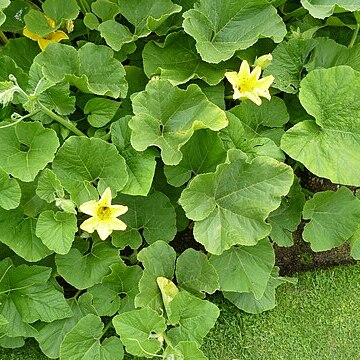Perennial herbaceous climbers, usually with tuberous rootstock, stem and leaf blades without black glandular hairs; dioecious. Probract absent in sterile shoots, in inflorescences present or absent. Tendrils unbranched or 2-branched and spiralling only above the point of branching. Leaves: blade simple, unlobed (elsewhere palmately lobed or 3-9-foliolate), ovate, green or brown on drying. Flowers: petals yellow, free. Male inflorescences: bracteate racemes or panicles, rarely flowers solitary. Male flowers: receptacle-tube shallow, with eccentric half-globose basal disc; sepals linear to (narrowly) ovate; petals 1-3 with an adaxial basal scale; stamens (3-)5, inserted near base or throat of receptacle-tube, often in two pairs and one solitary, filaments long, anthers 1-thecous, thecae short, not curved, erect. Female flowers solitary (or few in short racemes or panicles), perianth as in male; style single with 3 style arms, stigmas subglobose; staminodes 5. Fruits solitary, (narrowly) ellipsoid, carnose, indehiscent, ribbed or verrucose, or smooth, hairy. Seeds numerous, ovoid or ellipsoid, finely sculptured, with or without narrow margin, edge entire.
Herbs, perennial, climbing, scandent, or prostrate. Roots usually tuberous. Stems herbaceous, scabrous. Tendrils simple or 2-fid. Leaves mostly simple, vary rarely pedately 3-7-foliolate; leaf blade cordate, margin dentate. Plants dioecious. Male flowers in cymes-racemes or rarely solitary; calyx tube broadly campanulate or cupular; segments 5, linear, lanceolate, ovate-lanceolate, or oblong, 1-3-veined; corolla yellow, campanulate, 5-partite; segments oblong, broadly ovate, or obovate, usually 5-7-veined, entire; stamens 5, inserted on calyx tube, free, often 4 in pairs, other 1 free; filaments short; anthers oblong or ovoid, all 1-celled; anther cell erect; rudimentary ovary glandlike. Female flowers solitary or 2-or 3-fascicled on a short peduncle; calyx and corolla as in male flowers; ovary ovoid, oblong, or fusiform, smooth or verrucose; ovules numerous, horizontal; style 3-fid; stigmas 3, 2-lobed, reniform. Fruit fleshy, indehiscent, smooth or verrucose, many ribbed or not ribbed. Seeds numerous, horizontal.
Medium-sized climbers. Leaves simple or less often pedately 3–7-foliolate. Tendrils simple or proximally or distally bifid. Flowers of medium size, usually yellow, dioecious. Male flowers racemose, less often solitary; receptacle-tube short; lobes entire, linear or lanceolate; petals 5, free, entire, 1–3 with an incurved scale inside at the base; stamens 5, free, 4 in two pairs with one single, all 1-thecous; thecae straight. Female flowers solitary or few and fasciculate; ovules horizontal, many; style 1, stigmas 3. Fruit fleshy, indehiscent, tuberculate, ribbed or smooth. Seeds small, pyriform in outline and compressed, with rough testa and grooved margins, or oblong-or ovate-truncate in outline with flat ± prominently ridged faces and rounded margins.

